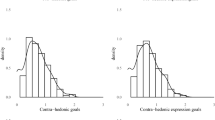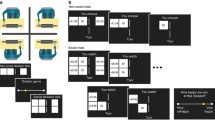Abstract
We find suggestive evidence that emotional balance has an impact on probability weighting incremental to demographic controls. Specifically, low negative affectivity (implying high emotional balance) tends to be a characteristic of those whose probability weighting functions exhibit lower curvature and more neutral elevation. In other words, emotional balance seems to push people in the direction of normative expected utility theory.
Similar content being viewed by others
Notes
See Abdellaoui et al. (2008) for a discussion of different definitions of loss aversion.
Probabilistic insensitivity (implied by these parameters exceeding 1.0) entails mid-range probabilistic insensitivity coupled with over-sensitivity in the neighborhood of the endpoints.
Figure A1 of the Web-Appendix shows probability weighting functions based on the Tversky and Kahneman (1992) estimated parameters, as well as those estimated here.
For example, using TK and Tversky and Kahneman’s (1992) median values of \(\gamma \) and \(\delta ,\) the intersections with the 45-degree line are at \(q = .34\) (for \(\gamma \)) and \(q = .38\) (for \(\delta \)).
Prelec (1998) imposes the constraint \(\gamma =\delta \) for both his one-parameter and two-parameter models, showing this follows from his axiomatic approach. We find that both under P1 and P2 this constraint cannot be rejected for a majority of the subjects in our sample.
See Web-Appendix for the experimental instructions along with screen shots viewed by participants.
These questions as well as all other categories of questions are provided in the Web-Appendix.
It is based on the PANAS instrument developed by Watson et al. (1988), who show that NA and PA are by and large uncorrelated, internally consistent and stable over time.
The 33 questions from Schutte et al. (1998) were subjected to factor analysis by Petrides and Furnham (2000), who identified four factors, which they labeled optimism/mood regulation (9), appraisal of emotions (9), social skills (11), and utilization of emotions (4), where the number of questions with the highest loading on a particular factor is in brackets. Our questionnaire omits the 11 “social skills” questions, leaving us with 22 questions.
See the Web-Appendix (Table A1; Fig. A3) for a table (with more detail) and frequency distributions.
While the independent variables are clearly correlated, their degree of correlation is not severe enough so that multicollinearity is a problem.
See Table A2 of Web-Appendix.
If we restrict ourselves to one-parameter models, it is essentially a dead heat.
From this point on the paper deals with estimates of PT parameters, not the true parameters. As a verbal abbreviation, however, we still speak of parameters when we really mean their estimates, but no confusion is likely to ensue from this. See the Web-Appendix for frequency distributions of the probability weighting function parameters (Fig. A4) as well as for the value function parameters \(\alpha \) and \(\beta \) (Fig. A5).
Using the P1 and P2 median values of \(\gamma , \delta , \gamma _{1}, \delta _{1}, \gamma _{2}\) and \(\delta _{2}\) it is apparent (see Fig. A1 of the Web-Appendix) that these lead to probability weighting functions not unlike those estimated by Tversky and Kahneman (1992).
In Fig. A4 of Web-Appendix, we also report frequency distributions for \(\Gamma ,\Gamma _{1}, \gamma _{2 }\)and \(\delta _{2}.\)
While \(\alpha \) and \(\beta \) are not relevant to our hypotheses, we also ran regressions of these parameters on the same set of variables (both with and without the constraint that \(\gamma =\delta \)). The principal finding was that in the negative domain, males were closer to EUT in the sense that \(\beta \) was higher (i.e., typically closer to linearity).
These are White’s test statistic for heteroscedasticity of unknown form, a redundant variable F test and White’s LM test for model misspecification.
These two parameters do not quite cleanly decompose these two behavioral tendencies. See Fehr-Duda et al. (2006) for a discussion.
This is the same percentage rejection as the \(\gamma =\delta \) test under P1.
It should be noted that results for \(\gamma _{2}\) and \(\delta _{2 }\) will vary depending on whether or not the \(\gamma _{1} = \delta _{1 }\) condition is imposed.
Results without 10 % filtering are broadly similar, but weaker (see Tables A6 and A7 of the Web-Appendix).
See Web-Appendix for comparable tables (A14, A15). In the same Web-Appendix, Tables A11–A13 for GE are comparable to Tables A3–A5 for P2.
References
Abdellaoui, M., Bleichrodt, H., & Paraschiv, C. (2008). Loss aversion under prospect theory: A parameter-free measurement. Management Science, 53, 1659–1674.
Barnea, A., Cronqvist, H., & Siegel, S. (2010). Nature or nurture: What determines investor behavior? Journal of Financial Economics, 98, 583–604.
Barrett, L. F. (1998). Discrete emotions or dimensions? The role of valence focus and arousal focus. Cognition and Emotion, 12, 579–599.
Bechara, A., Damasio, H., Tranel, D., & Damasio, A. R. (1997). Deciding advantageously before knowing the advantageous strategy. Science, 275, 1293–1295.
Booij, A. S., van Praag, B. M. S., & van de Kuilen, G. (2010). A parametric analysis of prospect theory’s functionals for the general population. Theory and Decision, 68(1–2), 115–148.
Brackett, M., & Mayer, J. (2003). Convergent, discriminant, and incremental validity of competing measures of emotional intelligence. Personality and Psychology Bulletin, 29, 1147–1158.
Bruhin, A., Fehr-Duda, H., & Epper, T. (2010). Risk and rationality: Uncovering heterogeneity in probability distortion. Econometrica, 78, 1375–1412.
Cesarini, D., Johannesson, M., Lichtenstein, P., Sandewall, O., & Wallace, B. (2010). Genetic variation in financial decision-making. Journal of Finance, 65, 1725–1754.
Dhar, R., & Wertenbroch, K. (2000). Consumer choice between hedonic and utilitarian goods. Journal of Marketing Research, 37, 60–71.
Edmans, A., Garcia, D., & Norli, O. (2007). Sports sentiment and stock returns. Journal of Finance, 62, 1967–1998.
Edwards, W. (Ed.). (1992). Utility theories: Measurements and applications. Kluwer Academic Publishers, Dordrecht, the Netherlands.
Etchart-Vincent, N., & l’Haridon, O. (2011). Monetary incentives in the loss domain and behavior towards risk: An experimental comparison of three reward schemes including real losses. Journal of Risk and Uncertainty, 42, 61–83.
Fehr-Duda, H., de Gennaro, M., & Schubert, R. (2006). Gender, financial risk and probability weights. Theory and Decision, 60, 283–313.
Gohm, C. L., & Clore, G. L. (2000). Individual differences in emotional experience: Mapping available scales to processes. Personality and Social Psychology Bulletin, 26, 679–697.
Goldstein, W. M., & Einhorn, H. J. (1987). Expression theory and the preference reversal phenomena. Psychological Review, 94, 236–54.
Hirshleifer, D., & Shumway, T. (2003). Good day sunshine: Stock returns and the weather. Journal of Finance, 58(3), 1009–1032.
Johnson, E. J., Hershey, J., Meszaros, J., & Kunreuther, H. (1993). Framing, probability distortions and insurance decisions. Journal of Risk and Uncertainty, 7, 35–51.
Kahneman, D., & Tversky, A. (1979). Prospect theory: An analysis of decision under risk. Econometrica, 47, 263–291.
Kamstra, M. J., Kramer, L. A., & Levi, M. D. (2000). Losing sleep at the market: The daylight saving anomaly. American Economic Review, 90, 1005–1011.
Kamstra, M. J., Kramer, L. A., & Levi, M. D. (2003). Winter blues: A SAD stock market cycle. American Economic Review, 93, 724–743.
Kaplanski, G., & Levy, H. (2010). Sentiment and stock prices: The case of aviation disasters. Journal of Financial Economics, 95, 174–201.
Larsen, R. J., & Buss, D. M. (2008). Personality psychology (3rd ed.). New York: McGraw-Hill.
Lo, A. W., & Repin, D. V. (2002). The psychophysiology of real-time financial risk processing. Journal of Cognitive Neuroscience, 13, 323–339.
Lo, A. W., Repin, D. V., & Steenbarger, B. N. (2005). Fear and greed in financial markets: A clinical study of day traders. Working paper.
Loewenstein, G. F. (1996). Out of control: Visceral influences on behavior. Organizational Behavior and Human Decision Processes, 65, 272–292.
Loewenstein, G. F. (2000). Emotions in economic theory and economic behavior. American Economic Review, 90, 426–432.
Loewenstein, G., Weber, E. U., Hsee, C. K., & Welch, N. (2001). Risk as feelings. Psychological Bulletin, 127, 267–286.
MacGregor, D. G., Slovic, P., Dreman, D., & Berry, M. (2000). Imagery, affect, and financial judgment. Journal of Psychology and Financial Markets, 1, 104–110.
Mano, H. (1994). Risk-taking, framing effects and affect. Organizational Behavior and Human Decision Processes, 57, 59–82.
Mayer, J. D., Roberts, R. D., & Barsade, S. G. (2008). Human abilities: Emotional intelligence. Annual Review of Psychology, 59, 507–536.
Petrides, K. V., & Furnham, A. (2000). On the dimensional structure of emotional intelligence. Personality and Individual Differences, 29, 313–320.
Prelec, D. (1998). The probability weighting function. Econometrica, 66, 497–528.
Rottenstreich, Y., & Hsee, C. K. (2001). Money, kisses and electric shocks: On the affective psychology of risk. Psychological Science, 12, 185–190.
Salovey, P., & Mayer, J. D. (1990). Emotional intelligence. Imagination, Cognition and Personality, 9, 185–211.
Schutte, N. S., et al. (1998). Development and validation of a measure of emotional intelligence. Personality and Individual Differences, 25, 167–177.
Shiv, B., Loewenstein, G., Bechara, A., Damasio, A., & Damasio, H. (2005). Investment behavior and the dark side of emotion. Psychological Science, 16, 435–439.
Stott, H. P. (2006). Cumulative prospect theory’s functional menagerie. Journal of Risk and Uncertainty, 32, 101–130.
Summers, B., & Duxbury, D. (2007). Unraveling the disposition effect: The role of prospect theory and emotions. Working paper.
Thompson, E. R. (2007). Development and validation of an internationally reliable short-form of the positive and negative affect schedule. Journal of Cross-cultural Psychology, 38, 227–242.
Tversky, A., & Kahneman, D. (1992). Advances in prospect theory: Cumulative representation of uncertainty. Journal of Risk and Uncertainty, 5, 297–323.
von Gaudecker, H.-M., van Soest, A., & Wengström, E. (2011). Heterogeneity in risky choice behavior in a broad population. American Economic Review, 101, 664–694.
Wakker, P. P. (2010). Prospect theory for risk and ambiguity. Cambridge, UK: Cambridge University Press.
Watson, D., & Clark, L. A. (1984). Negative affectivity: The disposition to experience aversive emotional states. Psychological Bulletin, 96, 465–490.
Watson, D., Clark, L. A., & Tellegen, A. (1988). Development and validation of brief measures of positive and negative affect: The PANAS scales. Journal of Personality and Social Psychology, 54, 1063–1070.
Acknowledgments
An anonymous referee of this journal provided helpful comments, as did James Choi, Werner DeBondt, Mark Kamstra, Lisa Kramer, Andy Previtero, Kent Womack, and attendees at Queen’s University’s Annual Behavioral Finance Conference (2011) and National Taiwan University’s International Conference on Economics, Finance and Accounting (2011), along with workshops at Thammasat University of Thailand (2011) and National Cheng Chi University of Taiwan (2011). Remaining errors are our own responsibility.
Author information
Authors and Affiliations
Corresponding author
Electronic supplementary material
Below is the link to the electronic supplementary material.
Rights and permissions
About this article
Cite this article
Charupat, N., Deaves, R., Derouin, T. et al. Emotional balance and probability weighting. Theory Decis 75, 17–41 (2013). https://doi.org/10.1007/s11238-012-9348-x
Published:
Issue Date:
DOI: https://doi.org/10.1007/s11238-012-9348-x




